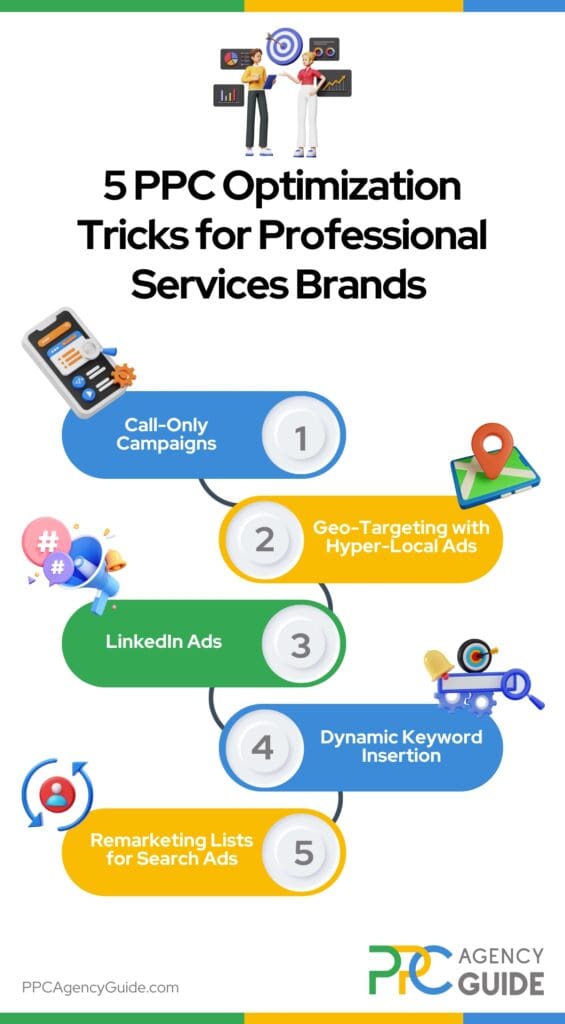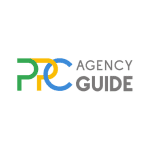
Did you know that a typical business generates $2 in revenue and $8 in profit for every $1 spent on Google Ads, per the platform’s research? However the business and professional services industry has one of the highest pay-per-click (PPC) costs, benchmark studies show. In other words, it’s not just about generating clicks if you’re advertising for a lawyer, accountant, architect, IT specialist, or other type of service provider. Your professional services PPC strategies must also ensure you get the right clicks. On this page, we’ll walk you through a few advanced techniques for PPC optimization for professional services companies that you’re probably not already leveraging and what’s involved in setting each one up.
1. Call-Only Campaigns
For professional services companies, immediate and direct communication with potential clients is often crucial. Call-only campaigns streamline this process by encouraging users to call your business directly from the ad. This can be especially effective for services that require personalized consultations, emergency assistance, or detailed explanations.
How Call-Only Campaigns Work
Call-only campaigns are designed specifically for mobile devices. Instead of driving users to a website, the ad encourages them to call your business directly. When users click on the ad, it initiates a phone call rather than redirecting them to a landing page.
Benefits of Call-Only Campaigns
- Immediate Engagement: Potential clients can connect with your business instantly, increasing the likelihood of conversion.
- Higher Intent: Users who call are often further down the funnel and more likely to convert than those who simply visit a website.
- Enhanced Trust: Direct phone communication can help build trust and rapport, which is particularly important for professional services.
- Improved Ad Performance: Call-only ads that cater to high-intent users can lead to higher click-through rates (CTR) and conversion rates.
Key Elements of a Call-Only Campaign Strategy
- Headline and Description: The ad should have a compelling headline and description that clearly states the benefits of calling.
- Call-to-Action (CTA): Use CTAs like “Call Now” or “Speak with an Expert Today.”
- Call Extensions: These extensions add a phone number to your ad, making it easy for users to call.
- Location Extensions: Show your business address to build trust and help users know they are contacting a local provider.
- Device Targeting: Ensure that your call-only campaigns are targeted to mobile devices since they are the ones capable of making calls.
- Geo-Targeting: Focus on specific geographic areas where your services are available. This is especially useful for local services.
- Scheduling: Schedule your ads to run during business hours when someone is available to answer calls.
- Call Tracking: Set up call tracking to measure the performance of your call-only campaigns. Use tools like Google Ads’ call tracking to see how many calls are generated.
- Conversion Tracking: Track which calls lead to conversions to optimize your ad spend.
2. Geo-Targeting with Hyper-Local Ads
Geo-targeting with hyper-local PPC ads allows businesses to reach potential clients in very specific geographic locations. For professional services companies, this means targeting businesses in areas where your services are most needed or where you have a competitive advantage. Hyper-local targeting can increase ad relevance, reduce wasted ad spend, and improve conversion rates.

How Geo-Targeting with Hyper-Local Ads Works
Geo-targeting involves setting your ads to appear in specific geographic areas, such as cities, zip codes, or even specific neighborhoods. Hyper-local targeting takes this a step further by focusing on very narrow areas, ensuring your ads reach the most relevant audience.
Benefits of Geo-Targeting with Hyper-Local Ads
- Increased Relevance: Ads tailored to specific locations are more relevant to the audience and increase engagement and conversion rates.
- Reduced Wasted Spend: Focusing on hyper-local areas minimizes ad spend on irrelevant clicks, improving overall ROI.
- Enhanced Competitive Advantage: Targeting specific areas where you have a competitive edge can help you stand out and attract more clients.
- Better Customer Relationships: Localized ads can build stronger connections with potential clients who value local expertise and presence.
Key Elements of Geo-Targeting with Hyper-Local Ads Strategy
- Identify Target Areas: Determine the specific geographic areas that are most relevant to your business. Focusing on areas with high business density or specific needs increases the likelihood of engagement.
- Customized Ad Copy: Tailor your ad copy to the specific needs and characteristics of the targeted area. Personalized ad copy can increase relevance and appeal to local businesses.
- Use of Location Extensions: Add location extensions to your ads to display your business address and contact information. Location extensions build trust and make it easy for local businesses to contact you.
- Ad Scheduling: Schedule your ads to run when your target audience is most likely to be searching. Ensuring your ads are seen at optimal times increases the chances of engagement.
- Monitor and Adjust: Regularly monitor the performance of your geo-targeted ads and adjust your strategy based on results. Continuous optimization ensures your ads remain effective and cost-efficient.
3. LinkedIn Ads
For professional services companies that want to connect with other businesses or professionals, LinkedIn Ads are an excellent tool. LinkedIn provides a platform where professionals network, and nearly one-third of its users have a master’s or doctorate degree, according to Hootsuite. This makes it ideal for reaching decision-makers, influencers, and high-income individuals.Explore more about leveraging LinkedIn Ads for your professional services brand to connect with high-quality leads and decision-makers.
How LinkedIn Ads for Professional Services Work
LinkedIn offers several ad formats, such as Sponsored Content, Sponsored InMail, Text Ads, and Dynamic Ads. The ads can be targeted based on user profiles, job titles, industries, company sizes, and more, allowing for precise audience targeting.
Benefits of LinkedIn Ads for Professional Services
- Professional Audience: LinkedIn is a platform used primarily by professionals for networking, making it a prime space to reach business decision-makers.
- Detailed Targeting Options: LinkedIn allows for granular targeting based on job titles, industries, company sizes, skills, and even specific LinkedIn groups. Increased relevance and precision in reaching potential clients who need your services.
- High-Quality Leads: LinkedIn’s professional nature means that leads generated from LinkedIn ads are often more serious and closer to making purchasing decisions. The quality of leads is likely to lead to higher conversion rates and better ROI.
- Enhanced Trust and Credibility: LinkedIn ads can enhance your brand’s credibility as they appear in a professional context. Showcasing expertise and professional reputation can help you build trust with potential clients.
Key Elements of a Professional Services LinkedIn Ads Strategy
- Ad Formats: Sponsored content, sponsored InMail, text ads, and dynamic ads can help you connect with your audience in different ways.
- Targeting Criteria: Target by job titles and functions, industry, company size, skills, and groups to ensure your message reaches the right people.
- Professional Tone: Maintain a professional tone that resonates with LinkedIn’s audience.
- Clear Value Proposition: Clearly explain the benefits of your services and include a strong call to action.
- Visuals: Use high-quality images or videos that align with your brand’s professionalism.
- Conversion Tracking: Implement LinkedIn’s conversion tracking to measure ad effectiveness.
- A/B Testing: Regularly test different ad creatives, headlines, and targeting criteria to optimize performance.
- Engagement Metrics: Monitor engagement metrics like likes, shares, and comments to gauge content resonance.
4. Dynamic Keyword Insertion
Dynamic Keyword Insertion (DKI) is a powerful feature in PPC advertising that automatically updates ad text to include the exact keywords a user searches for. For professional services companies, DKI can significantly enhance ad relevance, improve Quality Scores, and increase CTR.
How Dynamic Keyword Insertion Works
DKI dynamically updates your ad text to match the user’s search query, provided the query matches one of your keywords. This makes your ad appear more relevant to the user, as it mirrors their exact search terms. To use DKI, you insert a special piece of code into your ad text, such as {KeyWord: Default Text}, where “Default Text” is shown if the keyword cannot be dynamically inserted.
Benefits of Dynamic Keyword Insertion
- Increased Ad Relevance: Ads that closely match user search queries are more likely to be seen as relevant. Higher relevance can lead to improved Quality Scores and higher ad positions.
- Improved Click-Through Rates: Ads that match user queries are more likely to be clicked. Increased CTR leads to better ad performance and more traffic.
- Better Quality Scores: Google Ads uses relevance as a factor in calculating Quality Scores. Higher Quality Scores can lower cost-per-click (CPC) and improve ad rank.
- Enhanced User Experience: Users prefer ads that precisely match their search terms. The improved user experience can increase conversions
Key Elements of a Dynamic Keyword Insertion Strategy
- Comprehensive Keyword List: Ensure you have a well-researched list of relevant keywords that potential clients might use.
- Ad Code: Use the DKI code correctly to insert keywords into your ad text.
- Default Text: Always include a fallback default text for instances where the keyword insertion might not fit.
- Review Keywords: Ensure all potential keywords make sense in the context of the ad and won’t create awkward or incorrect phrases.
- Preview Ads: Use ad preview tools to see how your ads will look with different inserted keywords.
- A/B Testing: Regularly test different variations of ads with and without DKI to measure performance differences.
5. Remarketing Lists for Search Ads
Remarketing Lists for Search Ads (RLSA) allow professional services companies to customize their search ads and tailor bids for past website visitors. This PPC strategy helps reconnect with potential clients who have already shown interest in your services, increasing the likelihood of conversion.
How Remarketing Lists for Search Ads Work
RLSA uses cookies to track users who have visited your website. These users are added to remarketing lists, and you can then adjust your search ad campaigns to target these specific lists. This customization can include bid adjustments, tailored ad copy, and even targeting specific search queries.
Benefits of Remarketing Lists for Search Ads
- Higher Conversion Rates: Targeting users who have already visited your site means reaching an audience that is already familiar with your brand. Since these users have already shown interest, there is an increased chance of conversion.
- Improved Ad Relevance: Customize ad copy and offers based on previous interactions with your site. More relevant ads lead to higher engagement and better user experience.
- Cost Efficiency: Bid higher on high-intent keywords when targeting past visitors and lower bids for generic searches. This allows you to boost budget efficiency by focusing on more promising leads.
- Customized Bidding Strategies: Adjust bids based on user behavior and likelihood to convert to maximize ROI by allocating budget to users most likely to convert.
Key Elements of an RLSA Strategy
- Audience Segmentation: Create different lists based on user behavior, such as page views, time on site, and past interactions.
- Personalized Messages: More than half of all consumers favor personalization, with younger generations having a deeper appreciation for it, Statista reports. Develop ad copy that speaks directly to the needs of your segmented audiences.
- Dynamic Bidding: Set higher bids for high-value segments or users who have shown high intent.
- Avoid Redundancy: Exclude users who have already converted to prevent wasting ad spend.
- Monitor Performance: Use analytics to track the performance of your RLSA campaigns. Incorporating a thorough PPC audit into your performance monitoring routine ensures that your campaigns remain efficient, uncovering areas for improvement and optimizing for better results.
Get Expert PPC Optimization for Your Professional Services Company
While these PPC tips for service companies can help boost your ad effectiveness and ROI, they require advanced knowledge and additional time investment that in-house teams can’t always provide. We’re happy to match you with an agency that specializes in effective PPC for service businesses and can implement strategies like those outlined here and more. Take the next step toward improved PPC optimization with a complimentary consultation.

PPC Optimization for Professional Services Companies FAQs
What are effective PPC tactics for service firms?
Effective PPC tactics for service firms include using long-tail keywords, implementing Dynamic Keyword Insertion (DKI), and utilizing geo-targeting for local reach. Additionally, call-only campaigns and remarketing lists for search ads (RLSA) can improve engagement and conversion rates by targeting high-intent users and past visitors.
How can professional services companies benefit from call-only campaigns?
Call-only campaigns enable professional services companies to connect directly with potential clients via phone. These campaigns target mobile users, encouraging immediate contact. Benefits include higher conversion rates, as callers often have high intent, and enhanced trust through direct communication. They are especially effective for services requiring personalized consultations or urgent assistance.
What are the best geo-targeting strategies for PPC ads?
Effective geo-targeting strategies include focusing on specific geographic areas where your services are most needed, using location-specific keywords, and tailoring ad copy to local audiences. Additionally, leveraging location extensions and ad scheduling to target peak times in your area can enhance relevance and engagement, leading to higher conversion rates and better ROI.
How does LinkedIn advertising work for B2B companies?
LinkedIn advertising is ideal for B2B companies as it allows precise targeting based on job titles, industries, company sizes, and more. Ad formats include Sponsored Content, Sponsored InMail, and Text Ads. LinkedIn ads help reach decision-makers and professionals, generating high-quality leads and enhancing brand credibility through professional and targeted messaging.
What is Dynamic Keyword Insertion (DKI) in PPC advertising?
Dynamic Keyword Insertion (DKI) automatically updates your ad text to match the search query, increasing ad relevance. By inserting the exact keywords users search for, DKI can improve CTRs and Quality Scores. It makes ads more engaging by aligning with user intent, leading to better performance and higher conversion rates.
How can remarketing lists for search ads (RLSA) improve PPC performance?
RLSA allows you to tailor search ads for users who have previously visited your website. This increases ad relevance and conversion rates by targeting an audience already familiar with your brand. By customizing bids and ad copy based on past interactions, RLSA helps re-engage potential clients, making campaigns more cost-effective and impactful.
What are the key elements of a successful LinkedIn ad campaign for professional services?
Successful LinkedIn ad campaigns for professional services include precise targeting (job titles, industries), professional ad copy, and high-quality visuals. Utilize Sponsored Content and InMail for direct engagement, and track performance with conversion tracking and A/B testing. Tailor messages to address specific needs and establish credibility through thought leadership content.
How do I create effective PPC ads for professional services?
Effective PPC ads for professional services feature compelling headlines, clear value propositions, and strong calls to action. Use relevant keywords and tailor ad copy to address client needs. Leverage ad extensions like callouts and location extensions. Continuously test different ad variations and monitor performance to optimize for better results.
What are the advantages of using hyper-local ads in PPC campaigns?
Hyper-local ads target specific geographic areas, increasing relevance and engagement. For professional services, this means reaching local clients more effectively. Benefits include reduced wasted spend, improved ad relevance, and enhanced competitive advantage by focusing on areas where your services are most needed. Localized ads can also build stronger client relationships.
How can professional services companies track and measure the success of their PPC campaigns?
Track and measure PPC success using conversion tracking to monitor actions taken by users after clicking ads. Analyze key metrics such as clickthrough rate (CTR), conversion rate, and cost per conversion. Use tools like Google Analytics and LinkedIn Analytics to gain insights. Regularly review and adjust campaigns based on performance data to optimize results.
What are the best strategies for optimizing PPC for professionals?
Optimizing PPC for professionals involves using targeted keywords, crafting compelling ad copy, and employing strategic bidding. Additionally, leveraging ad extensions, A/B testing, and ensuring landing page relevance can enhance performance. Continuous monitoring and adjustments based on data insights are crucial for achieving optimal results.
How do lead generation PPC services work for professional companies?
Lead generation PPC services focus on creating targeted ads that drive potential clients to take action, such as filling out a form or calling your business. These services include keyword research, ad creation, and campaign management aimed at attracting high-quality leads interested in your professional services.
How can PPC management for professionals improve campaign performance?
PPC management for professionals involves continuous optimization of campaigns through keyword refinement, ad copy testing, and bid adjustments. By monitoring performance metrics and using advanced strategies like remarketing and audience segmentation, PPC managers can enhance ad relevance, increase CTR, and drive more conversions.
What are key elements of services company ad optimization?
Key elements of services company ad optimization include targeted keyword selection, compelling and relevant ad copy, effective use of ad extensions, and optimized landing pages. Regular performance analysis and A/B testing are essential to refine campaigns and improve ROI.
What strategies can be used for PPC improvement for professionals?
For PPC improvement for professionals, focus on optimizing keyword selection, enhancing ad copy, and utilizing ad extensions. Conduct detailed keyword research to identify high-performing and relevant keywords. Improve ad copy by making it compelling and relevant, with clear calls to action. Use ad extensions like callouts, site links, and structured snippets to increase ad visibility. Regularly perform A/B testing to identify the most effective ad elements. Continuously analyze performance data to make informed adjustments, such as bid optimizations and adding negative keywords. Ensure landing pages are relevant, user-friendly, and optimized for mobile devices to boost conversion rates. By systematically addressing these areas, professionals can achieve significant PPC improvement.
Which PPC strategies are most effective for manufacturing companies?
Manufacturing companies benefit from specialized PPC strategies tailored to their industry. These include using geo-targeted ads for specific locations, LinkedIn advertising to reach decision-makers, and implementing call-only campaigns to connect with high-intent prospects. Partnering with a manufacturing PPC agency can significantly enhance campaign performance by leveraging industry-specific strategies that maximize ROI. Explore more about manufacturing PPC agencies to find the right fit for your needs.


















